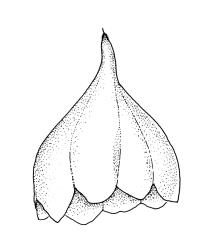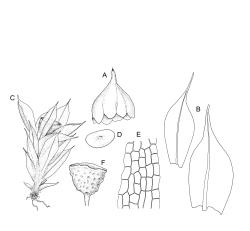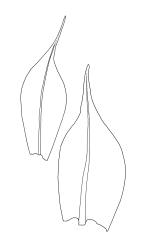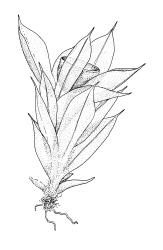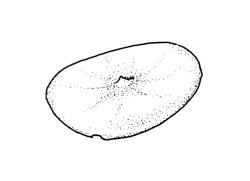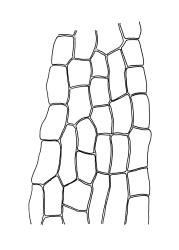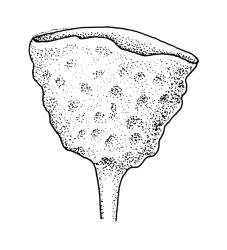The following description is based mainly on material from Western Australia and Queensland.
Plants pale green to brown, on mineral soil. Stems red-brown, erect, unbranched or branched, beset with red-brown, smooth rhizoids below, c. 2 mm, with no distinct cortical layer and a weak central strand. Leaves erect to weakly erect-spreading when moist, moderately contorted when dry, ovate to ovate-lanceolate, gradually tapered to an acuminate apex, (1.0–)1.6–2.0(–2.2) × (0.3–)0.5(–0.8) mm, including the acumen, which is ⅓ to ½ the length of the leaf, concave; margins plane, entire, and unbordered; upper laminal cells rather firm-walled, quadrate to oblong to weakly hexagonal, variable in size, (20–)52–65(–100) × (15–)21–24(–27) µm, becoming more regularly oblong in mid leaf but not differing in size, nearer insertion larger and oblong, (53–)75–95 × 27–32 µm, with a band of yellow-brown cells at insertion. Costa yellow, narrow, c. 50 µm wide at mid leaf and excurrent to fill a slender acumen in well-developed leaves (in N.Z. material), sometimes fading in lower portion of leaf (in Australian material) and in small leaves often ± absent. Axillary hairs present, 4-celled, c. 140 µm long; with terminal cell c. 60 × 12 µm (only one seen).
Paroicous but with antheridia not associated with all perichaetia. Antheridia often associated with reduced, ecostate leaves; paraphyses with inflated terminal cells usually present. Setae pale yellow, c. 1 mm, in cross-section with a single cortical layer and lacking a central strand; capsule broadly ellipsoid to globose, c. 1.0 × 0.8 mm, yellow-brown, operculate, gymnostomous, strongly and irregularly wrinkled when dry; exothecial cells irregularly oblong to polygonal, c. 27–40 µm in greater dimension, thin-walled, c. 8 rows of cells transversely elongate and thick-walled below the mouth; mouth transverse, slightly smaller in diameter than the mature capsule; operculum yellow at maturity, convex, composed of irregularly arranged, thin-walled cells; annulus as per genus; stomata numerous, superficial, funariaceous, restricted to capsule base. Calyptra broadly mitrate, 1–1.2 mm long, 1 mm diam., with a short (<0.2 mm long) rostrum, with eight radial pleats and eight-lobed at base, completely covering the immature capsule and often persisting after dehiscence. Spores yellow-brown in mass, ± ellipsoid, appearing minutely verrucate or smooth under light microscope, becoming reticulate at maturity, in polar view oval to isodiametric, in lateral view convex distally, flat to slightly concave proximally, with a long, narrow, monolete aperture, mostly (60–)70–80(–110) µm in greater diam.
Catcheside 1980, figs 133–134; Stone 1981, pl. 1, a–d, fig. 1, a–e, i–t; Fife 1985, pl. 9, fig. 88, pl. 11, fig. b (as G. acuminatum subsp. africanum). The subsp. enerve is illustrated by Wilson 1846 (pl. 3).
Confusion in N.Z. would be most likely with the relatively widespread Gigaspermum repens. However, Goniomitrium can be easily distinguished from that species by, inter alia, lack of fleshy subterranean stems, the presence of a single excurrent costa, the pleated nature of the calyptra, and much smaller (mostly 70–80 vs 150–190 µm) spores. The fleshy subterranean primary stems in Gigaspermum repens can be difficult to observe in herbarium material and are often overlooked.
NI: Hawke’s Bay (Napier).
Australasian. Mainland Australia (W.A.*, S.A.*, N.S.W.*, Qld*, N.T.*).
All members of the genus occur on bare soil, mostly following periods of heavy rain. No habitat details are known from the single 19th century N.Z. collection, which was associated with Microbryum starckeanum.
The occurrence of this species in N.Z. is based on S. Berggren 1405, a collection made at Napier in Aug. 1873 and preserved in NY. A small number of fruiting stems (CHR 573733) have also been isolated from another Berggren collection of Microbryum starckeanum from the same locality.
It is probable that this species dispersed naturally from Australia and temporarily established. Following its 1873 collection by the gifted collector S. Berggren, no further populations have been discovered in nearly 150 years. In the most recent report on the conservation status of N.Z. mosses (Rolfe et al. 2016), G. acuminatum is treated as a vagrant species.
In Fife & Seppelt (2001) the describing authors of G. acuminatum were given incorrectly as Hook.f. et Wilson, whereas the first author is W.J. Hooker ("Hook.") rather than "Hook.f.".
In Australian material examined the development of the costa in G. acuminatum is variable, even within single populations. The types of both G. acuminatum and G. enerve Hook. & Wilson in Wilson [London J. Bot. 5: 142, 1846] were segregated from one James Drummond collection from Swan River, Western Australia. Other Australian herbarium specimens of Goniomitrium have been seen in which costal development is variable and from which more or less ecostate plants have been segregated and named as G. enerve. Fife & Seppelt (2001) treated the latter as a subspecies of G. acuminatum. The subspecific epithet acuminatum is not employed here.



